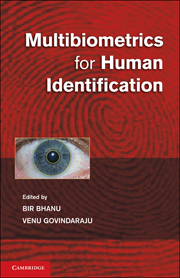Book contents
- Frontmatter
- Contents
- List of Contributors
- Preface
- Introduction
- PART I MULTIMODAL AND MULTISENSOR BIOMETRIC SYSTEMS
- PART II FUSION METHODS IN MULTIBIOMETRIC SYSTEMS
- PART III HYBRID BIOMETRIC SYSTEMS
- PART IV DATABASES AND SECURITY
- PART V PERFORMANCE OF MULTIBIOMETRIC SYSTEMS
- 14 Prediction for Fusion of Biometrics Systems
- 15 Predicting Performance in Large-Scale Identification Systems by Score Resampling
- Plate section
14 - Prediction for Fusion of Biometrics Systems
from PART V - PERFORMANCE OF MULTIBIOMETRIC SYSTEMS
Published online by Cambridge University Press: 25 October 2011
- Frontmatter
- Contents
- List of Contributors
- Preface
- Introduction
- PART I MULTIMODAL AND MULTISENSOR BIOMETRIC SYSTEMS
- PART II FUSION METHODS IN MULTIBIOMETRIC SYSTEMS
- PART III HYBRID BIOMETRIC SYSTEMS
- PART IV DATABASES AND SECURITY
- PART V PERFORMANCE OF MULTIBIOMETRIC SYSTEMS
- 14 Prediction for Fusion of Biometrics Systems
- 15 Predicting Performance in Large-Scale Identification Systems by Score Resampling
- Plate section
Summary
Introduction
To increase the accuracy of an individual human recognition, sensor fusion techniques (Bhanu and Govindaraju 2009; Kuncheva 2006; Ross et al. 2004) for multimodal biometrics systems are widely used today. For example, for a biometrics system, one can combine a face recognition system and a fingerprint recognition system to perform better human recognition. By fusing different biometrics, we may achieve the following benefits with the availability of more meaningful information: improved recognition/identification; reduction of false alarm, and broadening the range of populations for which the fused system will function satisfactorily.
There are four levels of fusion possibilities in a multimodal biometrics system (Waltz and Llinas 1990; Hall and Llinas 2001): data level, feature level, score level, and decision level. Data-level fusion is the combination of unprocessed data to produce new data expected to be more informative and synthetic than the single biometric data (Borghys et al. 1998). This kind of fusion requires a pixel-level registration of the raw images. When the sensors are alike, we can consider all data at the data-level fusion, but it is more complicated when several different sensors are used because of the problems associated with resolution, registration, etc. (Han and Bhanu 2007; Nadimi and Bhanu 2004). Feature level is believed to be promising because feature sets can provide more information about the input biometrics than other levels (Ross and Jain 2004). However, sometimes different feature sets are in conflict and may not be available, which makes the feature-level fusion more challenging than other levels of fusion (Ross and Govindarajan 2005; Zhou and Bhanu 2008).
- Type
- Chapter
- Information
- Multibiometrics for Human Identification , pp. 323 - 362Publisher: Cambridge University PressPrint publication year: 2011
- 1
- Cited by



